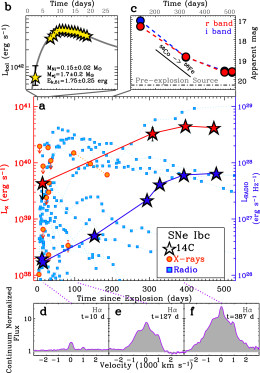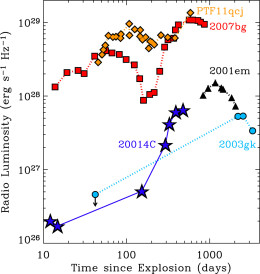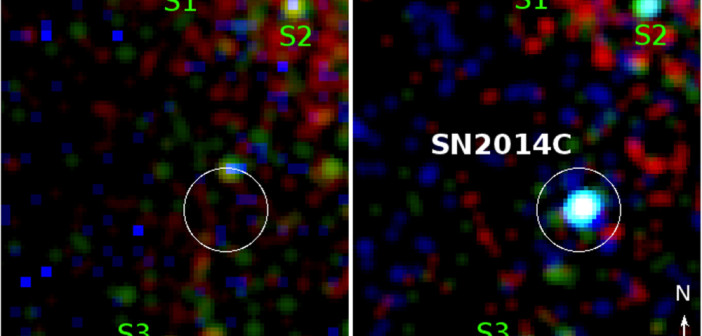For the first time ever, we’ve been able to watch the complete metamorphosis of an unusual explosion from one type of supernova to another. What do our observations of SN 2014C mean for our understanding of how massive stars end their lives?
Categorizing Explosions
Supernovae — the explosions that mark the end of massive stellar lifetimes — are broadly categorized into two types: Type I supernovae, which do not show evidence of hydrogen in their spectra, and Type II supernovae, which do.
The majority of supernovae in both categories have the same cause: the fuel in the star’s core is exhausted, and the core subsequently collapses under its own gravity. But a supernova will appear as a Type I or Type II depending upon whether or not the star had already lost its outer hydrogen envelope long before the explosion.

This plot summarizes key observational features of SN 2014C across the spectrum. The X-ray and radio evolution of SN 2014C is shown compared to other Type Ib/c supernovae (center panel). SN 2014C shows an uncommon rise in luminosity at late times, as well as the onset of Hα emission (bottom panel) when its shock plows into the hydrogen shell. [Margutti et al. 2017]
Supernova Surprise
SN 2014C has muddied this categorization, however. When this unusual explosion was first observed in December 2014, it looked like a Type Ib supernova: there was no sign of hydrogen in its spectrum. But over a timescale of roughly a year — during which it was continuously monitored across all wavelengths — SN 2014C transformed into a Type IIn supernova.
In a new study led by Raffaella Margutti (CIERA, Northwestern University), data is presented from close monitoring of SN 2014C over this entire transition period. The intriguing outcome? After about a year, SN 2014C’s expanding shock appears to have plowed into a substantial shell of hydrogen gas encasing the supernova.
Implications of an Unexpected Collision
How did this shell of hydrogen get there? Margutti and collaborators show that it must have been thrown off of the dying star in an eruptive episode decades to centuries before the supernova explosion.
This presents an interesting problem, because theoretical models of core-collapse supernovae typically assume that when a star loses its hydrogen envelope, this happens gradually over a long period of time, via a mechanism like strong stellar winds. If some stars are instead eruptively throwing off their outer layers long before they explode as supernova, we may need to make some serious changes in how we model stellar evolution and deaths in the future.

A few Type Ib/c supernovae that display late-time radio re-brightenings with similarities to SN 2014C. [Margutti et al. 2017]
Is SN 2014C Alone?
Margutti and collaborators suggest that SN 2014C might be a type of bridge supernova. In this picture, the difference between ordinary Type Ib/c supernovae and Type IIn supernovae (which show signs of interaction with a dense medium right away) lies only in when the star’s hydrogen envelope is thrown off: shortly before explosion for Type IIn supernovae, or decades to centuries beforehand for Type Ib/c supernovae.
When the authors search a sample of 183 Type Ib/c supernovae, they find that roughly 10% of the supernovae in their sample show signs of late-time interactions similar to SN 2014C, lending support to this picture.
We can certainly hope to gather observations of other supernovae behaving like SN 2014C in the future! In the meantime, our full look at SN 2014C’s transformation has given us plenty of new information to consider.
Citation
Raffaella Margutti et al 2017 ApJ 835 140. doi:10.3847/1538-4357/835/2/140


3 Comments
Pingback: a chameleon supernova
Pingback: How stars really pass on – Joliet Junior College – Astronomy 101 class blog
Pingback: Podcast CB S&R 104: Popurrí de noticias - La Ciencia de la Mula Francis